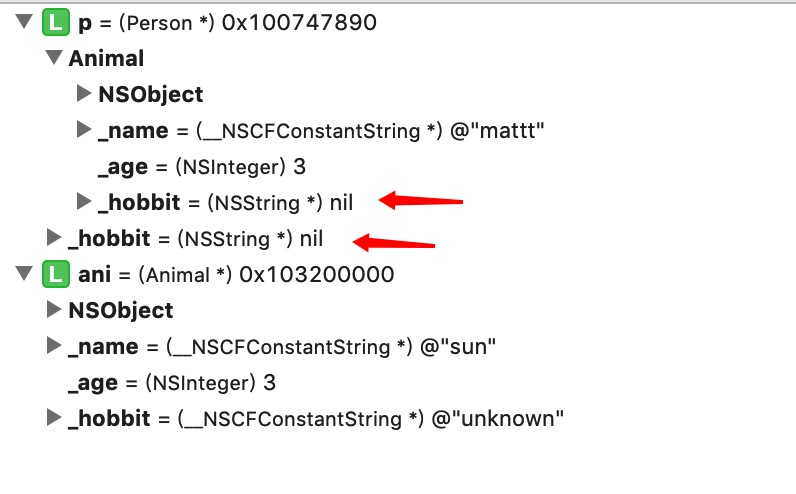对于私有属性和方法,子类和父类同名基本上没有什么影响.但是有几点需要注意一下:
如果是属性同名,子类和父类会拥有各自独立的实例变量。
如果是方法同名,按照消息发送的过程,执行的自然是子类中的方法。
举个栗子:
父类:
1
2
3
4
5
6
7
8
9
10
11
12
13
14
15
16
17
18
19
20
21
22
23
24
25
26
27
28
29
30
31
32
33
34
35
36
37
38
39
40
41
42
43
44
| @interface Animal : NSObject
@property (nonatomic, copy) NSString *name;
@property (nonatomic, assign) NSInteger age;
- (instancetype)initWithName:(NSString *)name age:(NSInteger)age;
- (void)hello;
@end
@interface Animal ()
@property (nonatomic, copy) NSString *hobbit;
@end
@implementation Animal
- (instancetype)initWithName:(NSString *)name age:(NSInteger)age {
self = [super init];
if (self) {
_name = name;
_age = age;
}
return self;
}
- (void)hello {
NSLog(@"父类方法,%@ %ld %@", _name, (long)_age, self.hobbit);
}
- (void)run {
NSLog(@"父类方法run");
}
- (NSString *)hobbit {
if (_hobbit == nil) {
_hobbit = @"unknown";
}
return _hobbit;
}
@end
|
子类:
1
2
3
4
5
6
7
8
9
10
11
12
13
14
15
16
17
18
19
20
21
| @interface Person : Animal
@end
@interface Person ()
@property (nonatomic, copy) NSString *hobbit;
@end
@implementation Person
- (void)hello {
[super hello];
NSLog(@"子类方法,%@ %ld %@", self.name, (long)self.age, self.hobbit);
[self performSelector:@selector(run)];
}
@end
|
属性同名,拥有各自独立的实例变量:

方法同名:
下面代码会打印什么?
1
2
3
4
5
| Person *p = ;
;
Animal *ani = ;
;
|
打印:
1
2
3
4
| 2020-03-23 10:17:13.648428+0800 父子类属性同名[47652:6589153] 父类方法,mattt 3 (null)
2020-03-23 10:17:13.648780+0800 父子类属性同名[47652:6589153] 子类方法,mattt 3 (null)
2020-03-23 10:17:13.648815+0800 父子类属性同名[47652:6589153] 父类方法run
2020-03-23 10:17:13.648853+0800 父子类属性同名[47652:6589153] 父类方法,sun 3 unknown
|
可以看到父类的hobbit属性是实现了懒加载的,但子类执行到父类hello方法里的self.hobbit时并没有执行懒加载代码,打印依然为null。这是因为执行self.hobbit时,执行的是子类自己的getter/setter方法。
之所以写这个,是因为在重构的时候发现上面的懒加载代码怎么死活都不执行。

